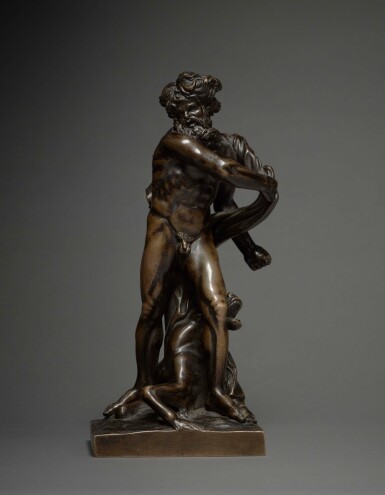
AFTER MICHEL ANGUIER | NEPTUNE
Lot Closed
May 27, 02:31 PM GMT
Estimate
4,000 - 6,000 GBP
Lot Details
Description
AFTER MICHEL ANGUIER
1612-1686
NEPTUNE
bronze
height: 24.5cm., 9⅝in.
Cast in France, late 17th century.
To view shipping calculator, please click here.
This elegant bronze represents the sea god Neptune standing on a hippocamp, directing the oceans, his drapery billowing about his body. The model was invented by the celebrated French sculptor Michel Anguier and owes a debt to Bernini's masterpiece Neptune and Triton in the Victoria and Albert Museum, London (inv. no. A.18:1-1950).
Anguier’s Neptune formed part of a set of six images of gods and goddesses commissioned in 1652. In 1690, they were described by Guillet de Saint-Georges, the first historian of the French Royal Academy of Painting and Sculpture, with the evocative titles of ‘a thundering Jupiter, a jealous Juno, an agitated Neptune, a tranquil Amphitrite, a melancholy Pluto, … and a weeping Ceres’. They were created as pairs to represent the elements of air (Jupiter and Juno), water (Neptune and Amphitrite) and earth (Pluto and Ceres), with the fourth element of fire lacking. Anguier’s Neptune exists in various collections in two sizes. The larger model (52 cm high) is in the National Gallery of Art, Washington; the Metropolitan Museum, New York, and the Victoria and Albert Museum, London among other collections. Smaller versions (24 cm high) exist in the Baltimore Museum of Art and the State Hermitage Museum, Saint Petersburg.
In the early versions of these bronzes, possibly cast in the 1660s, there was an hexagonal base and Neptune’s genitals were covered with flowing drapery. Anguier’s model was later adjusted, probably around 1670, and the present bronze, featuring a square base and exposed genitals, derives from this subsequent version.
The influence of Bernini’s famous Neptune and Triton (1622; now Victoria and Albert Museum, London) on Anguier has been noted by scholars, as elements of Bernini’s dramatic sculpture resonate in Anguier’s overtly Baroque composition. It represents the so-called ‘Quos Ego’ [‘Whom I’] from Virgil’s Aeneid. During the war between the Trojans and Greeks, the goddess Juno used the god of the winds to stir up a storm to kill the retreating Trojans. Neptune, angered by this intervention, calmed the waves by brandishing his trident and issuing the unfinished threat ‘Winds, do you dare, without my intent, to mix earth with sky, and cause such trouble, now? You whom I – ! ... But it’s better to calm the running waves: you’ll answer to me later for this misfortune, with a different punishment.’ Neptune’s chariot was drawn by hippocamps or sea-horses, one of which writhes between the god’s legs in the statuette.
Anguier was one of a number of French artists who moved to Rome, where he spent ten years from 1641, assisting the leading sculptors of the day, Gianlorenzo Bernini and Alessandro Algardi. Anguier received the commission for this series of gods and goddesses after returning to Paris in 1651, where he led a successful career. In his later years, he lectured at the Académie Royale on a variety of subjects, notably including different expressions of anger (1675) and depicting gods through their temperaments (1676).
